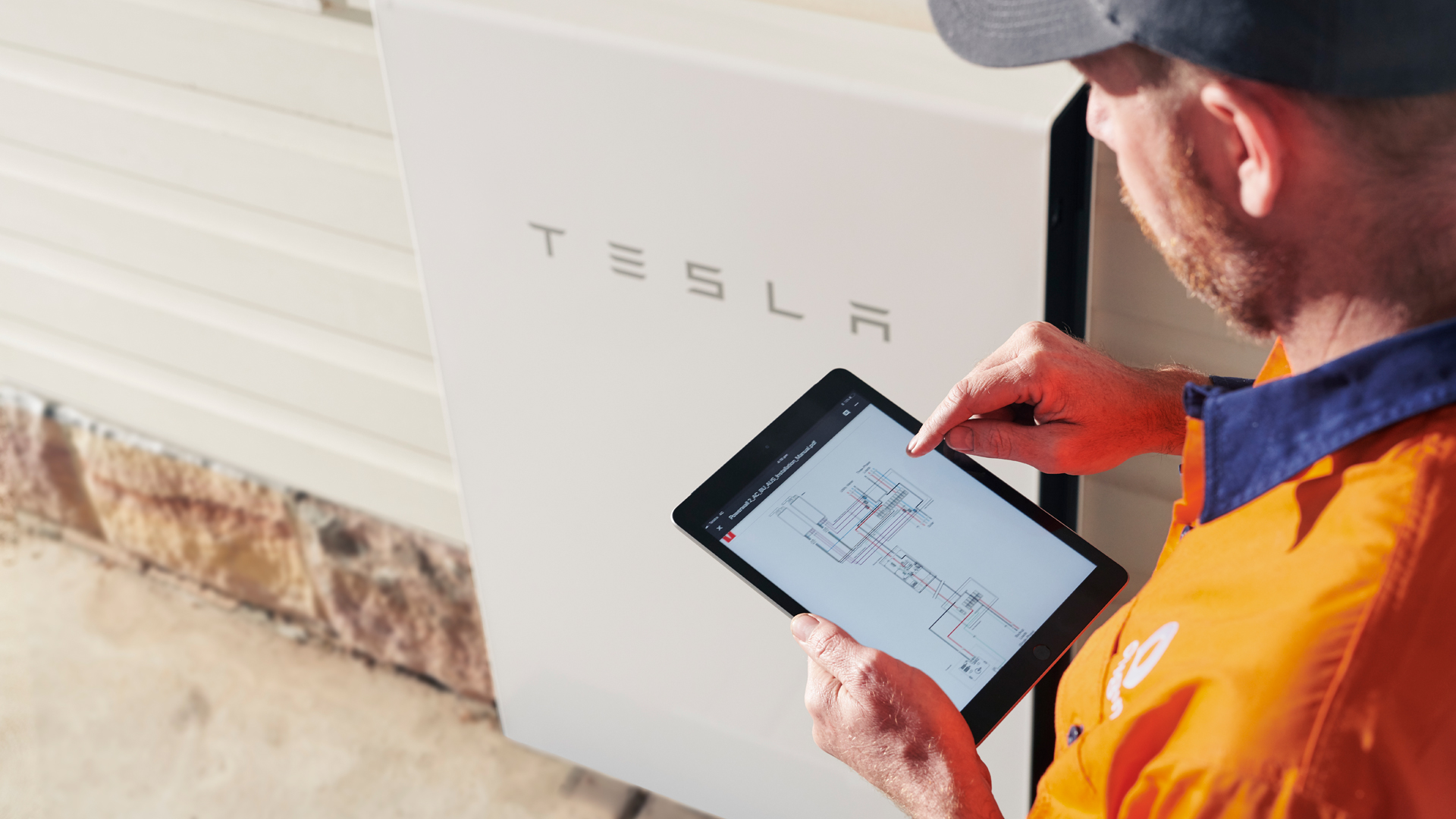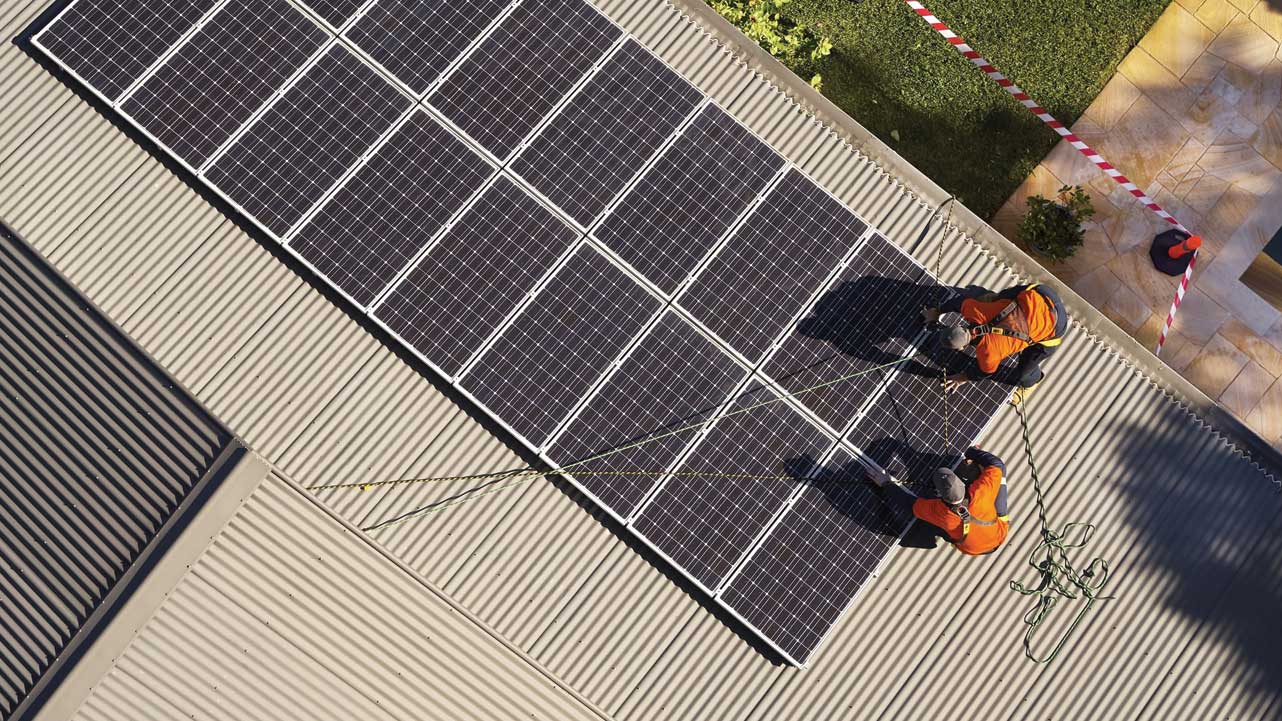How to install solar panels with Origin
Installing a solar energy system with Origin isn’t just one of the wisest decisions you can make – it’s also an easy one. We’ve installed more than 110,000 solar energy systems around Australia so far (still counting!) and we’ve worked hard to make a process that’s as seamless as possible.
Found the right solar system for your home? Get set up in 5 simple steps. Our Clean Energy Council (CEC) accredited installation team could get you saving money on your electricity bills in no time.
Step 1
Talk to our solar experts to design a solution for your home. Our consultants will send you a free quote, then a formal agreement will need to be accepted.
Step 2
One of our accredited installers will contact you to organise a date for installation. This will normally happen four to ten weeks after they contact you. In the meantime, you might need to make the necessary repairs and upgrades to get your property solar ready.
Step 3
An installation specialist will arrive on the agreed day. Someone over the age of 18 will need to be home for the installation to happen and, in most cases, the whole installation will take less than a day.
Step 4
After we’ve confirmed that your solar system is working as it should be, it’s time to get connected to the grid. Sign up for an Origin solar energy plan and we’ll get this done for you. Otherwise, you’ll need to get in touch with your electricity provider to complete this step
Step 5
Congrats! You can start enjoying your new system, track your solar savings via the Origin app, and watch the electricity bill savings start to roll in
How to prepare your property for a solar system
You might be keen to start harnessing renewable energy from the sun, but is your house ready for solar as well? Before installing a solar system, we’ll need to assess your property type, house condition, location, shading and orientation. Once that’s done, there might be a few extra things to do to prepare your home for a solar energy system.
Roof orientation and shading
In Australia, north-facing configurations will enable your solar panels to capture the most sunlight. To get the most from your solar system, you’ll also want your solar panels to have clear access to the sun.
Shade from trees, neighbouring buildings or roof fixtures like chimneys can affect the amount of power your system generates. Even if just one panel in your system is shaded by 50%, your entire system could be reduced by a similar amount. Learn more about solar panel positioning here.
Repairs and upgrades
Repair or replace a broken roof
Solar panels can last 20-25 years on average, so you’ll want to make sure that your roof can do the same. It’s important to get a qualified tradesperson to check the suitability and condition of your roof before solar panel installation. They’ll need to check for any damage and make the necessary repairs.
Materials such as tin, concrete and terracotta have different requirements when it comes to attaching the solar panels. This will affect the time it takes to install the panels and ultimately the cost of installation.
Upgrade your meter box and switchboard
You can upgrade to a solar-compatible smart meter if you have one that’s too basic to run with solar energy or is faulty. Otherwise, you might just need to replace a few components so that your meter and switchboard meet current safety standards. Learn more about meter and switchboard upgrades here.
Installation and safety equipment
On installation day, our Clean Energy Council (CEC) accredited solar technicians will be at your property to help set up your solar system and connect it to the grid.
To conduct a safe solar installation, our team might need to use the following safety equipment and procedures:
- AC isolator: An AC isolator is used for disconnecting the inverter from the grid for maintenance, repair or installations. If the switchboard is within 3 meters of the solar inverter installation, an AC isolator can be eliminated. Instead, a circuit breaker in the switchboard can be used to act as an AC isolator. The 3 meter rule becomes irrelevant if the switchboard is not in site of the solar inverter, for example there is a fence, in that instance an AC isolator would also be required.
- Metering neutral link: A metering neutral link is an earthing mechanism that is used to safely ensure that the circuits that are connected to your solar system, should anything go wrong, will either trip themselves or terminate so there won’t be any electrical damage. This is required to meet Australian safety and compliance standards.
- Shade awning: Direct sunlight can cause solar inverter ‘derating’ (that’s when a solar inverter reduces its power in order to protect it from overheating), which can reduce production and have an impact on warranties. Depending on wall space, it might be necessary to install shade awning on a north- or west-facing wall to help protect the inverter from harsh or extended sunlight.
- Scissor lift: A scissor lift may be required if the installers are unable to safely access your roof via ladder. A solar panel weighs roughly 19kg, so in order to keep our installers safe, it’s important that there’s a flat surface for a ladder to be placed, plus an appropriate height from ladder to roof. A scissor lift might also be recommended if it’s identified that there could be damage on your roof during the installation.
Meter box and switchboard upgrades
Any time metering works are completed, the meter and switchboard must meet current safety standards as set by your local electricity distributor and Standards Australia. The following are some typical electrical upgrades that might be required for your meter box and switchboard, to safely install your home solar system and connect it to the grid:

Meter box: Your meter box controls the flow of electricity to your home. It contains electrical components such as the meter, the main switch, fuses and circuit breakers. Depending on the construction and age of your property, you may need to make changes to your meter box and switchboard in order to get a solar system safely installed.
Backing board: If your backing board is made of asbestos or flammable materials (such as wood or chipboard), it will need to be replaced. Asbestos backing boards are commonly black and, if previously identified by an electricity company, will have a warning sticker.
Ceramic fuses: When adding a major appliance like a solar system to your property, it’s important to make sure the circuit can cope. Old ceramic fuses no longer meet safety standards, and are not as safe or convenient as circuit breakers.
Switchboard space: A larger switchboard may be required to fit any additional solar or electrical components required with your installation. For example, the main switch, export limiter or digital meter.
Relocation: It’s recommended that the inverter should be as close as possible to the switchboard, and facing away from a northern direction. It is sometimes difficult to identify this at the time of sale, and additional charges for cabling may be required. Additional factors such as your local distributor requirements, or having a swimming pool on the property can also impact inverter requirements.
Electrical standards in Australia change over time as technology improves. A switchboard installed in 1970 will have been subject to different standards compared to a switchboard installed in 1990, and there will be newer standards still for a switchboard installed today. As a result, some upgrades may be needed to bring a home up to the modern safety standards which are required for safe solar installation.
Want to know more?

Power on with a great solar plan
Want to make the most of your solar system? Explore our solar and electricity plans featuring low rates and great feed-in tariffs.

Add a solar battery to the mix
Capture, store and use solar energy even when the sun isn’t shining. Learn more about solar batteries and solar storage solutions now.

Expert maintenance and repairs
Keep your solar system in tip top condition. Book a solar technician now for solar panel inspection, cleaning and service.
Get an instant solar quote
We’ll use our smart technology to see if solar panels will work on your roof and recommend a solar solution for your home and energy needs.
 Have a question? Find Help & Support online anytime or call 1300 791 468 (Mon–Fri, 8am–7pm)
Have a question? Find Help & Support online anytime or call 1300 791 468 (Mon–Fri, 8am–7pm)
Important information
Origin solar systems and solar packages
Not available in all areas. Price for a standard installation on a tin roof single-storey house in Zone 3 and within 50 km of state GPO or an installer location (except in Canberra and Townsville where additional charges apply). All prices include GST and small-scale technology certificates (STCs). The system purchased must be eligible for STCs and you must assign the rights to the STCs to us. Additional meter changeover/installation fees charged by your distributor may apply. Prices subject to change without notice. Limit of one system per address per 6-month period unless we agree otherwise. For installation timeframes and full terms, ask us when you call.